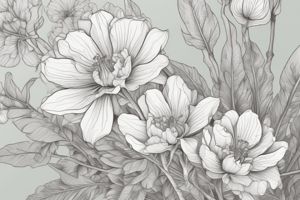Podcast
Questions and Answers
What is a key reason for studying carpel evolution in angiosperms?
What is a key reason for studying carpel evolution in angiosperms?
- It reveals the genetic similarities between different plant species.
- It provides knowledge about fungal relationships.
- It helps in understanding the diversification of angiosperms. (correct)
- It focuses solely on flower color variations.
What does the evolutionary pattern of carpels demonstrate regarding plant adaptation?
What does the evolutionary pattern of carpels demonstrate regarding plant adaptation?
- Plants have a remarkable capacity to adapt to various environments. (correct)
- Plants can only adapt to one environment over time.
- Plants can evolve through random mutations without environmental influences.
- Plants have limited capacity to adapt to specific pollination systems.
How can the study of carpel development be beneficial in agriculture?
How can the study of carpel development be beneficial in agriculture?
- It allows farmers to select traits purely based on aesthetic value.
- It eliminates the need for genetic modification in crops.
- It can inform breeding strategies to develop new cultivars. (correct)
- It primarily focuses on improving animal husbandry.
What should be considered when examining the diverse evolutionary paths of angiosperm lineages?
What should be considered when examining the diverse evolutionary paths of angiosperm lineages?
Which of the following statements accurately reflects the significance of carpel evolution Studying?
Which of the following statements accurately reflects the significance of carpel evolution Studying?
What are carpels in flowering plants?
What are carpels in flowering plants?
What was a common early hypothesis about the evolution of carpels?
What was a common early hypothesis about the evolution of carpels?
Which factor has influenced the evolution of carpel diversity according to modern understanding?
Which factor has influenced the evolution of carpel diversity according to modern understanding?
What is the role of genetic regulatory networks in carpel evolution?
What is the role of genetic regulatory networks in carpel evolution?
What process is common in the evolution of carpels?
What process is common in the evolution of carpels?
How does carpel structure relate to reproductive strategies in angiosperms?
How does carpel structure relate to reproductive strategies in angiosperms?
What can be concluded about the origin of the gynoecium?
What can be concluded about the origin of the gynoecium?
What does the modern view emphasize about the carpel evolutionary journey?
What does the modern view emphasize about the carpel evolutionary journey?
Flashcards
Carpel Evolution
Carpel Evolution
The evolution of the carpel, a key reproductive structure in flowering plants, has led to diverse variations across different lineages. This diversity reflects adaptations to specific environmental pressures and pollination strategies.
Understanding Angiosperm Diversification
Understanding Angiosperm Diversification
The study of carpel evolution provides valuable information about the origin and diversification of flowering plants, the most successful plant group on Earth.
Adaptation and Specialization
Adaptation and Specialization
Evolutionary patterns in carpels demonstrate the incredible flexibility of plants to adapt to different environments and pollination systems.
Horticulture and Agriculture
Horticulture and Agriculture
Signup and view all the flashcards
Carpel
Carpel
Signup and view all the flashcards
Early Models of Carpel Origin
Early Models of Carpel Origin
Signup and view all the flashcards
Modern Understanding of Carpel Evolution
Modern Understanding of Carpel Evolution
Signup and view all the flashcards
Origin of the Gynoecium
Origin of the Gynoecium
Signup and view all the flashcards
Fusion of Carpellary Leaves
Fusion of Carpellary Leaves
Signup and view all the flashcards
Modification of Leaf Structures
Modification of Leaf Structures
Signup and view all the flashcards
Flowering Plant Diversification
Flowering Plant Diversification
Signup and view all the flashcards
Study Notes
Introduction to Carpel Evolution
- Carpels are the female reproductive structures in flowering plants, forming the ovule-bearing part of the pistil.
- Understanding their evolutionary origins is vital for understanding the diversification of angiosperms.
- Carpel evolution is a complex process involving modifications of leaf-like structures.
Early Models of Carpel Origin
- Early hypotheses often proposed a single evolutionary lineage for carpel development.
- These models frequently focused on the fusion of leaf-like structures in the floral primordial.
- The mechanisms driving this fusion and the resulting diversity of carpel shapes were not well understood.
Modern Understanding of Carpel Evolution
- Current research recognizes a more multifaceted evolutionary pathway for carpels.
- Carpel diversity arises from modifications in leaf-like progenitor structures, potentially not solely through fusion.
- Different angiosperm lineages faced varying evolutionary pressures, shaping the observed carpel variations.
Key Evolutionary Processes
- Flowering Plant Diversification: Carpel evolution directly relates to the broader diversification of flowering plants.
- Reproductive Strategies: Carpel structure often reflects specific pollination strategies and fertilization processes within a lineage.
- Environmental Influences: Environmental factors like pollinator availability and seed dispersal methods have shaped carpel features through selection.
- Genetic Mechanisms: Genetic regulatory networks, conserved yet adaptable across lineages, are crucial in defining carpel structure and function during development.
Evolutionary Pathways and Models
- Fusion of carpellary leaves: A common mechanism involves the fusion of megasporophyll primordia into a single unit.
- Modification of Leaf Structures: Carpel evolution likely involved gradual alterations in leaf-like structures, leading to diverse carpel types.
- Origin of the gynoecium: The gynoecium, encompassing one or more carpels, evolved from modified megasporophylls—ancestral structures containing ovules—directly giving rise to carpels.
- Diverse Lineages: Different angiosperm lineages exhibit various evolutionary routes to comparable functional/morphological carpel traits, often driven by specific selective pressures within each lineage.
Significance of Carpel Evolution Study
- Understanding Angiosperm Diversification: Carpel evolution provides crucial insights into the origins and diversification of angiosperms, the dominant plant group.
- Adaptation and Specialization: Carpel evolution showcases remarkable plant adaptability to various environments and pollination systems.
- Horticulture and Agriculture: Understanding carpel development can inform breeding strategies in agriculture, potentially leading to new cultivars with desired traits and increased crop yields.
Studying That Suits You
Use AI to generate personalized quizzes and flashcards to suit your learning preferences.
Description
This quiz explores the evolution of carpels, the female reproductive structures in flowering plants. It covers early models of carpel origin and modern understandings that highlight the complexity and diversity of carpels in angiosperms. Test your knowledge on the evolutionary trajectory of these essential plant structures.




